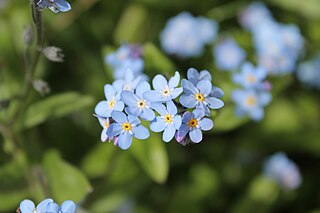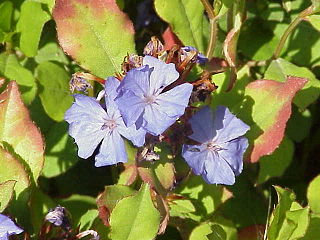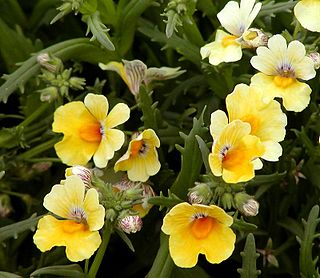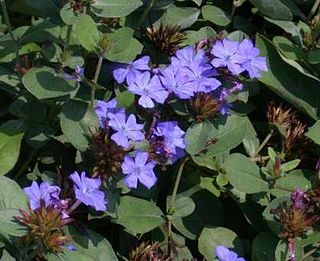
Deutzia is a genus of about 60 species of flowering plants in the family Hydrangeaceae, native to eastern and central Asia, and Central America and also Europe. By far the highest species diversity is in China, where 50 species occur.

Delphinium is a genus of about 300 species of annual and perennial flowering plants in the family Ranunculaceae, native throughout the Northern Hemisphere and also on the high mountains of tropical Africa. The genus was erected by Carl Linnaeus.

Hibiscus syriacus is a species of flowering plant in the mallow family, Malvaceae. It is native to south-central and southeast China, but widely introduced elsewhere, including much of Asia, both in the east and the west. It was given the epithet syriacus because it had been collected from gardens in Syria. Common names include the rose of Sharon,, Syrian ketmia, shrub althea, and rose mallow. It is the national flower of South Korea and is mentioned in the South Korean national anthem.

Echeveria is a large genus of flowering plants in the family Crassulaceae, native to semi-desert areas of Central America, Mexico and northwestern South America.

Hyacinthus orientalis, the common hyacinth, garden hyacinth or Dutch hyacinth, is a species of flowering plant in the family Asparagaceae, subfamily Scilloideae, native to southwestern Asia, southern and central Turkey, northwestern Syria, Lebanon and northern Israel. It was introduced to Europe in the 16th century. It is widely cultivated everywhere in the temperate world for its strongly fragrant flowers which appear exceptionally early in the season, and frequently forced to flower at Christmas time.

Cornus kousa is a small deciduous tree 8–12 m (26–39 ft) tall, in the flowering plant family Cornaceae. Common names include kousa, kousa dogwood, Chinese dogwood, Korean dogwood, and Japanese dogwood. Synonyms are Benthamia kousa and Cynoxylon kousa. It is a plant native to East Asia including Korea, China and Japan. Widely cultivated as an ornamental, it is naturalized in New York State.

Berberis thunbergii, the Japanese barberry, Thunberg's barberry, or red barberry, is a species of flowering plant in the barberry family Berberidaceae, native to Japan and eastern Asia, though widely naturalized in China and North America, where it has become a problematic invasive in many places, leading to declines in species diversity, increased tick habitat, and soil changes. Growing to 1 m tall by 2.5 m broad, it is a small deciduous shrub with green leaves turning red in the autumn, brilliant red fruits in autumn and pale yellow flowers in spring.

Myosotis sylvatica, the wood forget-me-not or woodland forget-me-not, is a species of flowering plant in the family Boraginaceae, native to Europe. This spring-flowering plant and its cultivars, typically with blue flowers, are the familiar forget-me-nots of gardens.

Ceratostigma (;), or leadwort, plumbago, is a genus of eight species of flowering plants in the family Plumbaginaceae, native to warm temperate to tropical regions of Africa and Asia. Common names are shared with the genus Plumbago.

Lobelia erinus is a species of flowering plant in the bellflower family Campanulaceae, native to southern Africa.

Viburnum plicatum is a species of flowering plant in the family Adoxaceae, native to mainland China, Korea, Japan, and Taiwan. The Latin specific epithet plicatum means "pleated", referring to the texture of the leaves.

Nemesia is a genus of annuals, perennials and sub-shrubs which are native to sandy coasts or disturbed ground in South Africa. Numerous hybrids have been selected, and the annual cultivars are popular with gardeners as bedding plants. In temperate regions they are usually treated as half-hardy, grown from seed in heat, and planted out after all danger of frost has passed.

Salvia microphylla, the baby sage, Graham's sage, or blackcurrant sage, is an evergreen shrub found in the wild in southeastern Arizona and the mountains of eastern, western, and southern Mexico. It is a very complex species which easily hybridizes, resulting in numerous hybrids and cultivars brought into horticulture since the 1990s. The specific epithet microphylla, from the Greek, means "small leaved". In Mexico it is called mirto de montes, or "myrtle of the mountains".

Hydrangea paniculata, or panicled hydrangea, is a species of flowering plant in the family Hydrangeaceae native to southern and eastern China, Korea, Japan and Russia (Sakhalin). It was first formally described by Philipp Franz von Siebold in 1829.

Polygala calcarea, the chalk milkwort, is a species of flowering plant in the family Polygalaceae, native to western Europe. It is a delicate mat-forming evergreen perennial growing to 5 cm (2 in) tall by 20 cm (8 in) broad, with spikes of small, vivid deep blue flowers in spring, and leathery, oval leaves.

Plectranthus fruticosus, the forest spurflower, is a species of flowering plant in the mint family, Lamiaceae. It is native to Mozambique, Eswatini, and South Africa's KwaZulu-Natal, Northern, and Cape provinces. Growing up to 2 m (6.6 ft) tall, it is an erect evergreen shrub, with rounded, hairy leaves, and spikes of soft blue or mauve flowers in summer.

Plectranthus oertendahlii is a species of flowering plant in the sage and mint family, Lamiaceae. Common names include silverleaf spurflower, Swedish ivy, Oertendahl's spurflower, November lights, and Brazilian coleus though it is native to eastern South Africa rather than Brazil. Plectranthus oertendahlii and the cultivar ‘Uvongo’ have gained the Royal Horticultural Society’s Award of Garden Merit.

Ceratostigma plumbaginoides (蓝雪花), the hardy blue-flowered leadwort, is a species of flowering plant in the plumbago family, native to Western China, where it is usually found in rocky foothills.

Sarcococca ruscifolia (野扇花) is a species of flowering plant in the box family Buxaceae, native to China, where it inhabits forested mountain slopes. Growing to 1 m (3.3 ft) tall and broad, it is a compact evergreen shrub with shiny oval leaves. Fragrant white flowers in winter are followed by red berries.

Stachyurus chinensis (中国旌节花), Chinese stachyurus, is a species of flowering plant in the family Stachyuraceae, native to China and Taiwan. It is a spreading deciduous shrub growing to 2.5 m (8 ft) tall by 4 m (13 ft) wide. Stiff, pendent racemes of bell-shaped, greenish-yellow flowers are borne on glossy, dark brown branches in winter and spring. It flowers two weeks later than the related S. praecox. The flowers are followed by simple ovate leaves which colour to pink and red before falling in autumn.




















